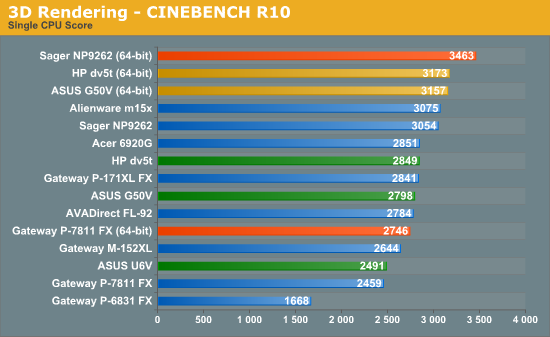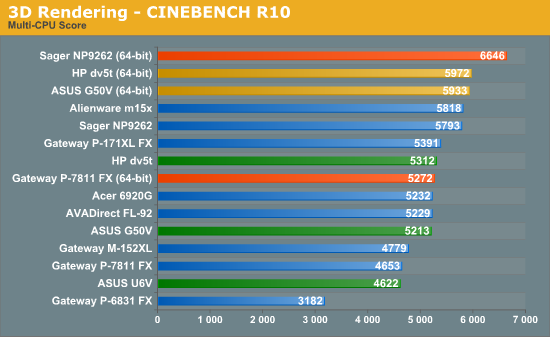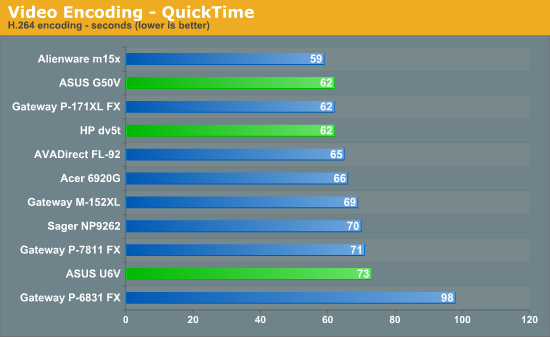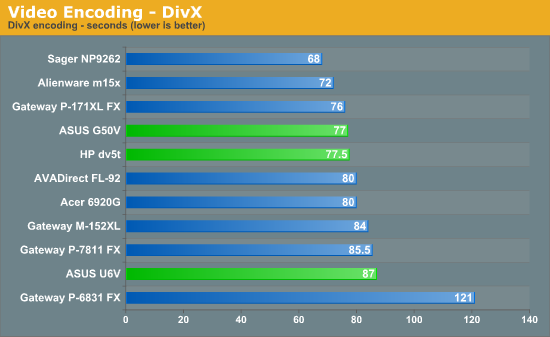General Application Performance
Wrapping things up with our performance testing, we have results from the Futuremark PCMark testing suites as well as some of our own application benchmarking. When it comes to running your office, multimedia, and Internet tasks, most modern laptops are more than fast enough. What follows are a few of the more strenuous application benchmarks - 3D rendering and video encoding - that put more of an emphasis on high CPU speeds. If you don't do that sort of thing on your computer, you will probably find that just about any Core 2 Duo processor is more than fast enough.






Both PCMark tests support the above statement, with a gap in performance of only 25% in PCMark Vantage between the fastest and slowest laptop tested. If we drop the P-6831, the gap between the U6V and the Sager/Alienware in video encoding is also about 25%, and slightly higher at 30% in CINEBENCH (32-bit). It's a shame the U6V doesn't get 64-bit Vista, especially since it has 2x2GB RAM and could benefit in at least a couple areas from a 64-bit OS. Still, there are businesses that continue to require 32-bit Windows for one reason or another.










27 Comments
View All Comments
JarredWalton - Friday, October 24, 2008 - link
I chatted a bunch with ASUS on this; there was some confusion so I may have ended up with the wrong conclusion. (Yeah, marketing wasn't positive on the specs, and engineering didn't ever pass on the exact details.) I actually had a paragraph detailing the differences between the 9800M GTS and this supposed 9800M GS. Since I don't have one in my hands, I can't say one way or the other with certainty.The worst case would appear to be clock speeds equal to that of the 8800M GTS (500 core instead of 600 core on the 9800M GTS), which is still going to be a lot faster than these other notebooks. Since it's also limited to 1366x768, gaming performance should be no problem at native res... but there's a lot of headroom left untapped. Certainly, gaming performance won't be lower than the G50V tested here, unless the game happens to be CPU limited.
Enrox - Friday, October 24, 2008 - link
Take a look at the Gateway P-7811 battery's life: it's about 150 minutes regarless the task (DVD playback, web surfing, H.264 playback).That to me says only one thing: no power management in place.
Is that a Vista issue or a BIOS issue?
JarredWalton - Friday, October 24, 2008 - link
Oh, the P-7811 is definitely doing *something* - though idle battery life is lower than I'd expect relative to the others. Actually, I think it's more that the P-7811 is doing quite well in other tasks. Remember: 17" 1920x1200 LCD, 7200 RPM HDD, and a 9800M GTS put it at a much higher power envelope than most of the other laptops. Relative to the P-6831 and m15x, the results seem to be right where you'd expect. If only Gateway had implemented Hybrid Power....jonmcc33 - Friday, October 24, 2008 - link
Did you verify that with the Power Saver setting that EIST was working properly? Use CPU-Z or similar to see if the clock speed of the FSB and CPU does change as it should. Check the BIOS settings as well.CU - Friday, October 24, 2008 - link
Yes it would be interesting to know what the cpu, gpu, fsb, and ram clocks are at when in power saving mode for Vista and OSX.JarredWalton - Friday, October 24, 2008 - link
CPU speed drops to a 6X multiplier, so at least that aspect is working. Looking at the voltages (according to CPU-Z), they're all at 1.083V except for the G50V, which runs at 1.338V most of the time. (I'm still trying to figure out what's going on there and will update when I know more.) I'm not as concerned with G50V battery life, though, since it's in a different class of performance and size; it's the U6V and similar notebooks that need to do a lot better.Regarding RAM, GPU, and FSB, the FSB stays locked at the base speed - 1066 MHz on the Centrino 2 notebooks. RAM likewise stays at a set speed, in this case 800 MHz. 2D GPU clocks (according to GPU-Z) are 169 MHz core, 200 MHz (100 base) VRAM on all three of these notebooks. GPU-Z also reports a memory clock of 800 MHz (400 base) for the HP dv5t, which seems wrong - I though the 9600M GT was supposed to be much faster RAM, but apparently not.
JarredWalton - Friday, October 24, 2008 - link
Update: The G50V was back on "High Performance" mode after rebooting (an issue with some of the ASUS software). Setting it back to "Balanced" or "Power Saver" dropped the CPU voltage to the expected voltage - though still slightly higher than the others at 1.063V.fabarati - Friday, October 24, 2008 - link
Asus is known for their crappy batterylife in the latest generation. When compared to equal or even better specced laptops, they fall flat on the ground. It's probably because of bad ACPI coding. My F8Sa has worse battery life than my old A8Js, despite having less powerhungry parts. And the A8Js had mediocre batterylife (I reached about 3½ hours, with hardware disabled). I can barely break 2 hours, and that's when I disable hardware.The HP DV5 seems to suffer from the same issue, at least that's the conclusion we came to when it was tested by NBR.
JarredWalton - Friday, October 24, 2008 - link
I haven't tested a comprehensive selection of laptops by any means, but if you look at the specs for the various laptops and the resulting Minutes/Whr chart you can see that if this is bad ACPI coding the practice extends far beyond just ASUS and HP. If the MacBook Pro was around 3 or 4 Min/Whr, I'd think maybe it was just some fine tuning that was missing, but it's still literally double what the closest tested Vista laptop managed.The best result I've personally seen on Vista to date is the http://www.anandtech.com/mobile/showdoc.aspx?i=328...">ASUS U2E, which manages 3.72 Min/Whr with the 86.5 Whr battery. That's a lot closer than the other laptops, but keep in mind that has a U7500 CPU (10W max TDP), X3100 IGP, and an SSD, plus an 11.1" LED LCD.
Another 15.4" laptop I'm currently testing with T7250 and X4500 graphics (plus 4GB RAM, 250GB 5400RPM HDD) manages 4.18 Min/Whr, which is closer to Apple. Still, that's a 50% advantage for the MacBook, so it's not really *that* close. (It gets 204 minutes of battery life in our web surfing test.)
nizanh - Friday, October 24, 2008 - link
Can't you just install Vista on one of the MacBooks?Sounds to me like the best testing methodology.